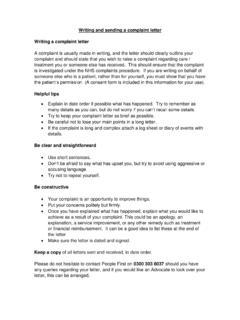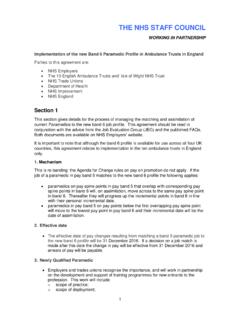Transcription of Control Room Standard Operating Procedure
1 Welsh ambulance Services nhs trust Control Services Standard Operating Procedures Deployment of Rapid Response Vehicles (RRVs) CONTROLLED DOCUMENT Version 7 1 Ymddiriedolaeth GIG Gwasanaethau Ambiwlans Cymru Welsh ambulance Services nhs trust Control Room Standard Operating Procedure for the Deployment of Rapid Response Vehicles (RRV s) Approved by Date Review Date Every 4 weeks Welsh ambulance Services nhs trust Control Services Standard Operating Procedures Deployment of Rapid Response Vehicles (RRVs) CONTROLLED DOCUMENT Version 7 2 Document History Version Date Author Reason for Change DistributionThis document has been distributed to: Name Title Date of Issue Version Health & Safety Committee Approvals Name Signature Title Date of Issue Version Welsh ambulance Services nhs trust Control Services Standard Operating Procedures Deployment of Rapid Response Vehicles (RRVs) CONTROLLED DOCUMENT Version 7 3 INDEX Page 1.
2 Introduction 4 2. Communications & Safeguards 4 3. Deployment Plan 4 4. Incident Support Desk management 5 5.
3 Unit Hour Objective 6 Welsh ambulance Services nhs trust Control Services Standard Operating Procedures Deployment of Rapid Response Vehicles (RRVs) CONTROLLED DOCUMENT Version 7 41. Introduction Rapid Response Vehicle operatives will be utilised at the discretion of the trust and will be deployed from their base station to any designated RRV deployment zone. The Control centre will utilise the RRVs in accordance with this Control Operating Procedure and the RRV standing Operating procedures to ensure maximum appropriate utilisation allowing for the best possible clinical care delivered in a timely fashion, to those patients requiring intervention.
4 2. Communications RRVs will be fitted with a fixed radio, a portable radio, a cellular phone and a satellite navigation system. 3. Deployment Plan Staff working on RRVs will be deployed dynamically by the ISD Dispatcher/Allocator, Duty Control Manager to meet the changing demands of service delivery. This will be a core function of the incident support desk (ISD). RRVs may also be deployed to calls outside their normal zone if resources are diminished. When on duty all RRV operatives will contact the ISD to be deployed to their designated zone. Night time stand-by will be at facilitated points or at a point mutually agreed by the RRV operative and the ISD.
5 Welsh ambulance Services nhs trust Control Services Standard Operating Procedures Deployment of Rapid Response Vehicles (RRVs) CONTROLLED DOCUMENT Version 7 5 4. Incident Support Desk management At times of low activity, the ISD will contact the RRV operative every sixty (60) minutes. In the event that the ISD or Control fail to make contact with the RRV, the nearest available resource will be sent to the last known position to verify the safety of the RRV operative. If no resource is available then the police should be contacted and asked to If not contacted by Control , RRV operatives will contact Control after 30 minutes. Where a member of staff crewing a RRV is at a facilitated stand-by location, the duty in section 4:1 can be relaxed.
6 The ISD will however continue to monitor any RRV operative on trust premises. RRVs will be utilised primarily for Cat A 999 incidents. However, an RRV may be deployed to all determinants of calls but may be stood down if the call transpires to be a lower category. When allocating an emergency call the Control will pass on all relevant information to the RRV at the earliest opportunity. RRV staff on being allocated to a call, will: Decide if they feel it safe to respond, based on either the ISD or the RRV operative s specific knowledge of the area and incident details. If it is felt to be unsafe, RRV operatives will decide to either stand down from the call, or proceed as in below.
7 This decision must be evidenced and recorded on the Control and Dispatch (CAD) system in all cases. The RRV operative should stand-off in a static location at a safe distance or adopt a rolling stand-by position and advise the ISD of their intended action following a dynamic risk assessment of the scene. In such cases, and on arrival at the stand-off area, the RRV operative should enter the status, At Scene , and remain at a safe distance until it is determined that it is safe to proceed. RRVs will not be deployed to; a) Psychiatric calls (including all intentional overdoses) b) Calls to night clubs c) Calls that are known to be of a violent nature Responses to public houses will be at the discretion of the RRV operative.
8 Welsh ambulance Services nhs trust Control Services Standard Operating Procedures Deployment of Rapid Response Vehicles (RRVs) CONTROLLED DOCUMENT Version 7 6 RRV s must be backed up by the next nearest available EMS ambulance unless stood down by the RRV operative. This will take precedence over any polling calls. In line with current practice, the ISD or Control will ask the RRV operative every Sunday morning to carry out a full Alpha Romeo test call on both fixed and portable radios. This will be recorded in Control . 5. Unit Hour Objective In relation to solo responders the trust has set specific key performance indicators of: 85% of category A responses attended by solo responders within 8 minutes.
9 A 45% contribution by solo responders to the 8 minute Standard . In order to meet the key performance indicators detailed above RRVs will be staffed to agreed resource levels. Due to changing nature of both resource and demand pressures placed upon the trust the following options should be considered in sequence to provide the necessary RRV cover. Utilise paramedics who are on duty to crew rapid response vehicles and who volunteer to do so. Redeploy staff from emergency ambulances (EA). Technician grade staff who have a minimum of 12 months post qualification experience may be asked if they are prepared to volunteer to respond if the RRV is not staffed. This will be on an ad-hoc basis, not pre-planned and only after and have been exhausted.
10 If this situation arises no duress should be placed upon any technician to carry out this role.






